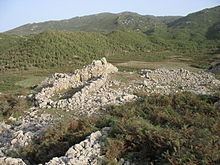In the thousands. 18. Year 1915 | Elevation 1,355 m | |
 | ||
Unknown Yesayi Yakhubian, Yesayi Aprahamian, Nerses Kazandjian, Movses Ter-Kalutsian and others Similar Jebel Musa, Jebel Aqra, Mount Ararat, Tahtalı Dağı, Mount Nemrut | ||
Musa Dagh (Turkish: Musa Dağı; Armenian: Մուսա լեռ, Musa leṛ; Arabic: جبل موسى Jebel Musa; meaning "Moses Mountain") is a mountain in the Hatay province of Turkey. In 1915 it was the location of a successful Armenian resistance to the Armenian Genocide, an event that inspired Franz Werfel to write the novel The Forty Days of Musa Dagh.
Contents
- Map of Musa Dagi C387amlC4B1yayla Mahallesi 31800 SamandaC49F2FHatay Turkey
- History
- The Forty Days of Musa Dagh
- References
Map of Musa Dagi, %C3%87aml%C4%B1yayla Mahallesi, 31800 Samanda%C4%9F%2FHatay, Turkey
History
The denizens of that region had been given an official order from the Turkish government to perform violent expulsions of six Armenian villages: Kabusia (Kaboussieh), Yoghunoluk, Bitias, Vakef, Kheter Bey (Khodr Bey) and Haji Habibli. This was a fragment of a wider operation conducted by the Ottomans since 1915. As Ottoman Turkish forces converged upon the town, the populace, aware of the impending danger, fell back upon Musa mountain and thwarted assaults for fifty-three days. One of the leaders of the revolt was Movses Der Kalousdian, whose Armenian first name was the same as that of the mountain. Allied warships, most notably the French 3rd squadron in the Mediterranean under command of Louis Dartige du Fournet, sighted the survivors, as Werfel was told, just as ammunition and food provisions were running out. The warships then transported them to safety in Port Said, Egypt. French and British ships, beginning with the Guichen, evacuated 4,200 men, women and children from Musa Dagh.
Nearly 250 men took part in the defense, fighting off Turkish armies in June 1915. The Armenians had refused deportation and fled to the highest mountain in the town, and from July to September 1915 they defended themselves until French ships rescued them. Starting in 1918, when Sanjak of Alexandretta came under French control, six Armenian villages returned to their homes.
In 1932 a monument was erected at the top of the mountain to commemorate the event. On 29 June 1939, following an agreement between France and Turkey, the province was given to Turkey. Afterwards Armenians from six of the villages emigrated from Hatay, while some of the residents of Vakıflı village chose to stay. Vakıflı is the only remaining ethnic Armenian village in Turkey, with a population only 140 Turkish-Armenians. Most who left Hatay in 1939 immigrated to Lebanon where they resettled in the town of Anjar. Today, the town of Anjar is divided into six districts, each commemorating one of the villages of Musa Dagh.
As the French squads came to the rescue of the remaining survivors, the chief priest was quoted to say: "The evil only happened ... to enable God to show us His goodness."
The Forty Days of Musa Dagh
These historical events later inspired Franz Werfel to write his novel The Forty Days of Musa Dagh (1933), a fictionalized account based on Werfel's detailed research of historical sources. A movie of the same name was released in 1982.
Werfel had told reporters: "The struggle of 5,000 people on Musa Dagh had so fascinated me that I wished to aid the Armenian people by writing about it and bringing it to the world".
